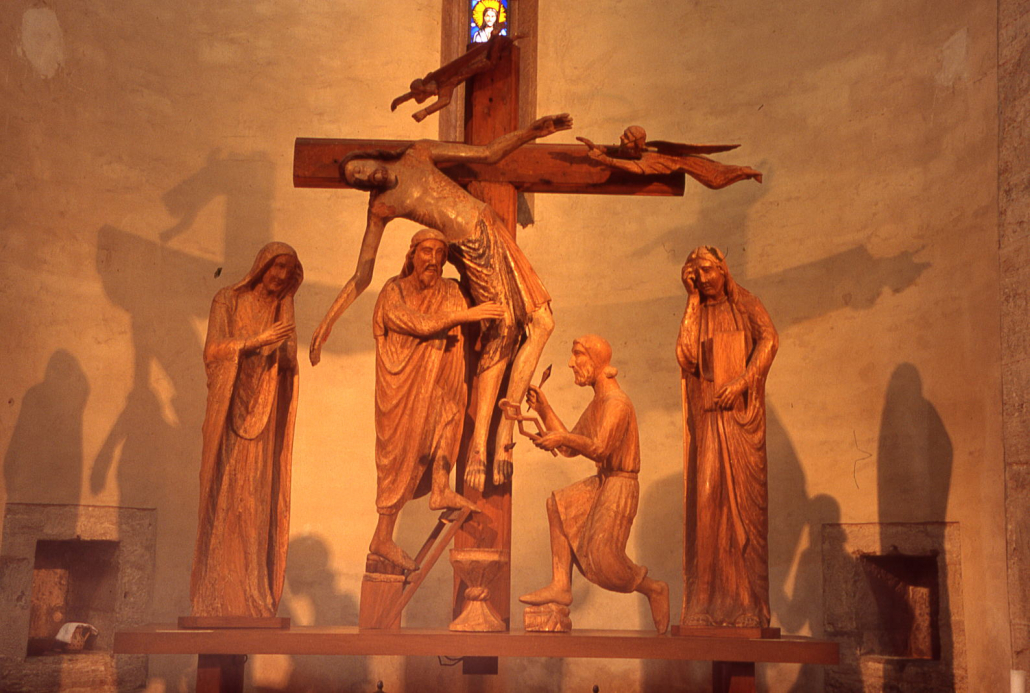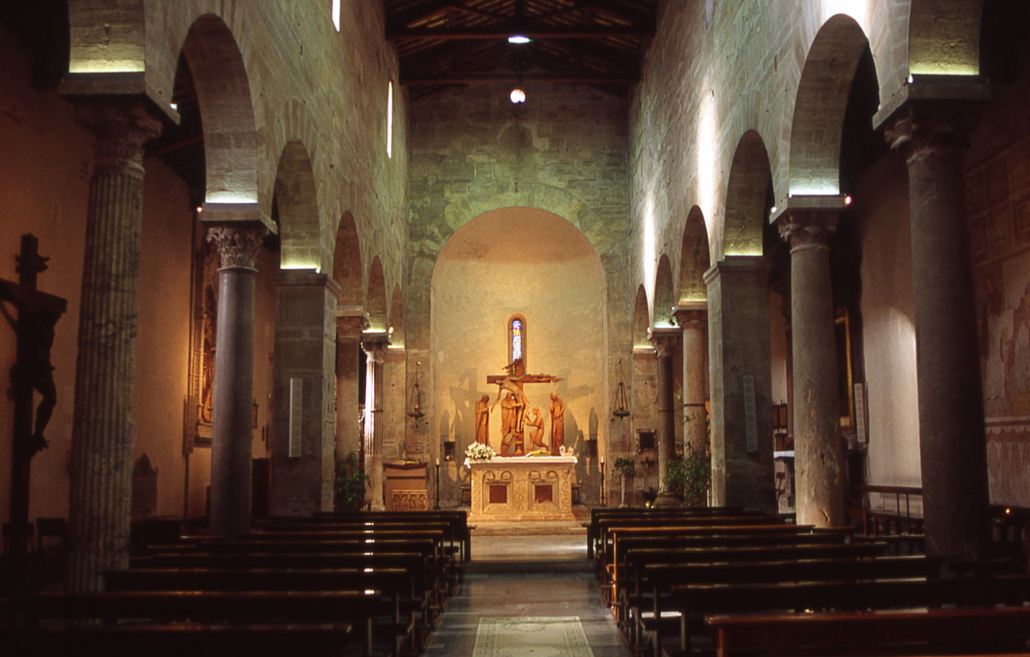The Parish of Santa Maria in Vicopisano, originally consecrated also to Saint John the Baptist, dates back to the 12th century. It is the oldest and most important church in Vicopisano area and is the only one to have been erected outside the wall enclosure. Furthermore, the entrance doesn’t face the West, as it usually did according to the ecclesiastic habits, but it faces one of the Castle access gates, Porta Miccioni, later to become Porta della Rocca. The Church was first mentioned in 934, but the document infers that it already existed some time before.
The Façace & The Outside
The present construction dates back to the 12th century; it is a well-preserved example of Pisan-Romanesque church, featured by a basilican plan with a single apse. The masonry is made in “verrucano” stones; the façade shows two orders horizontally divided by a cornice. The upper part – adorned by suspended arches – is featured by a double lancet window. The lower part – with three portals - is enriched by semicolumns that bear suspended arches; these are surmounted by “oeils-de-beuf” and contain rhomboidal shapes sculptured with geometrical and vegetable patterns. On top of the left pilaster there is a stone bas-relief that may be dated back to the 8th - 10th century, representing an episode of the Gospel.
The southern side is provided with a single door; it is featured in its upper part by four narrow single lancet windows, one of these decorated with vine branches and leaves. Both the side and the front part of the church are enriched by suspended small arches that enclose sculptured stones and rest on corbels decorated with human faces, animal figures and relief patterns. On the lower part of the south side we can observe some medieval inscriptions that testify the presence – at that time – of a cemetery around the church. On the north side there are - on the contrary - no decorations, as on this side there were a cloister and the parish priest house. The extensions of the side aisles and the bell-tower date back to the 18th century.
The southern side is provided with a single door; it is featured in its upper part by four narrow single lancet windows, one of these decorated with vine branches and leaves. Both the side and the front part of the church are enriched by suspended small arches that enclose sculptured stones and rest on corbels decorated with human faces, animal figures and relief patterns. On the lower part of the south side we can observe some medieval inscriptions that testify the presence – at that time – of a cemetery around the church. On the north side there are - on the contrary - no decorations, as on this side there were a cloister and the parish priest house. The extensions of the side aisles and the bell-tower date back to the 18th century.
The Interior
The inside of the church is divided in one nave and two aisles, each of them bearing 12 granite columns with varied capitals: the medieval capitals are in grey freestone; the first, the third and the last on the left are in sculptured marble with acanthus leaves, the last two rest on fluted marble columns that come from Roman Age buildings. Two pillars delimit the vast Presbytery area where the high altar is located; this has been reconstructed at the beginning of the 20th century reutilizing ancient relieves with vegetal and zoomorphic patterns that probably belonged to the early medieval church.
The Deposition from the Cross (13th century)
A magnificent wood Deposition from the Cross is positioned in the apse: it dates back to the first twenty years of the 13th century and has got evident similarities with the other Deposition which is in Volterra, also in Pisa district. It is a rare example - once widespread - of this typology of sacred representation, and the only one that still has preserved almost all the original figures: only the angels’ heads, some parts of Saint John and the chalice have been replaced through restoration. Traces of the paint that once covered the garments are still observable. The characters represented in the group are (from left to right): the doleful Madonna, John of Arimatea holding the Christ’s body, Nicodemus drawing out the nails from the Christ’s feet and Saint John with the Gospel in his hands. Beside being one of the few exemplars left, it is also one of the most singular, as the Christ’s figure is represented in a very unusual way: very arched and in the act of falling. Evidently, the artist had enough autonomy to break off from the usual models - that is the Christ nailed to the Cross – and to follow more “gothic” models, giving greater emphasis to arched and winding lines and replacing the straight and rigid lines which were typical of the Romanesque Age.
The Frescos (13th century)
Traces of some 13th century frescos- remain on the massive walls in “verrucano” stone, that have been recently restored. They represent scenes from the Gospel, testifying the habit to depict the Holy Histories, in order to make them more understandable to the uneducated believers (Biblia Pauperum). The cycle begins on right aisle wall, where scenes from the Annunciation, the Visitation and the Nativity are recognizable. The next episode is likely that of Erodes commanding the slaughter of the innocents. Above the narrative scenes there are ornamental patterns of spirals and squares alternated with checks, while the bottom is decorated with false draperies. On the internal face of the façade, on the left, two scenes are represented: the top one shows the Baptism of Christ, while on the bottom scene Saint George, the dragon and the Princess are recognizable. On the right, the restored traces of frescos are not interpretable. On the left aisle wall two scenes have been restored: the capture of Christ and the Pentecost. The entire cycle ended with the wood Deposition from the Cross, that concluded Jesus’ passage on earth. The cycle of frescos was covered up between the 16th and 17th century, when the still present big stone altars were positioned against the walls.






